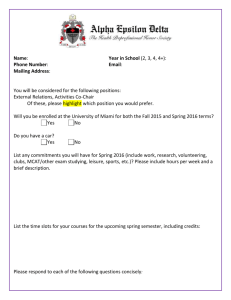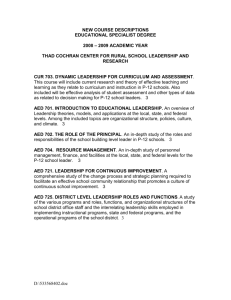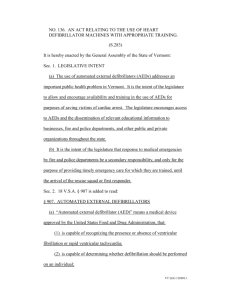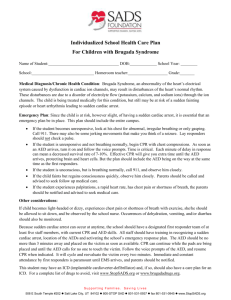NWAS AED FAQs - Cardiac Smart
advertisement
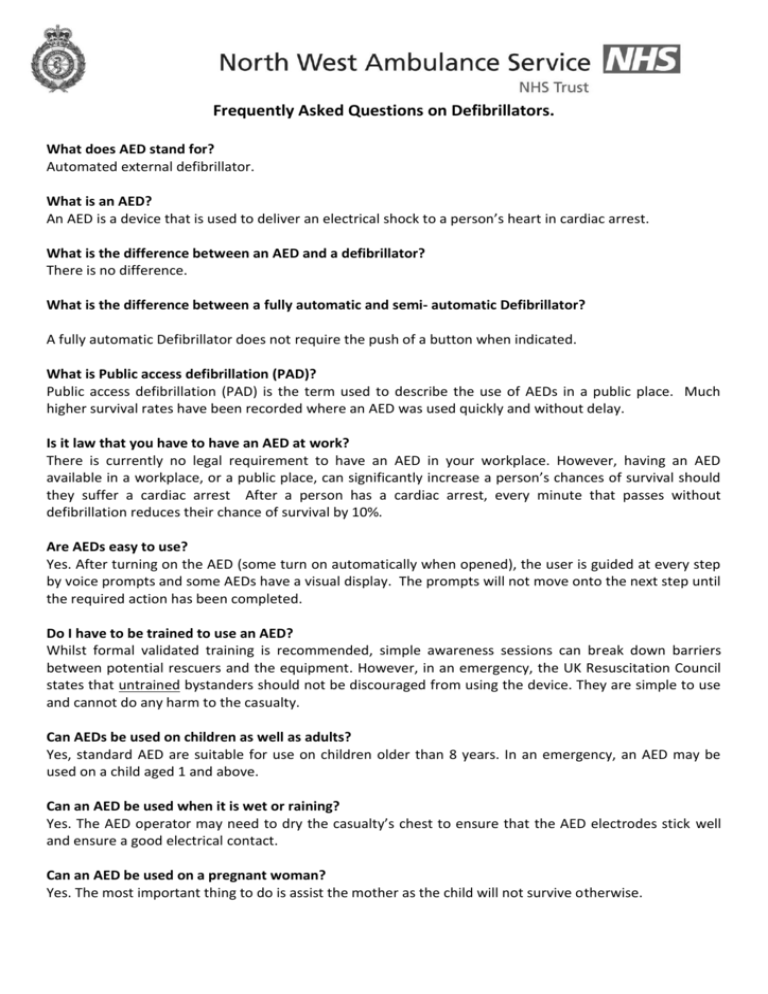
Frequently Asked Questions on Defibrillators. What does AED stand for? Automated external defibrillator. What is an AED? An AED is a device that is used to deliver an electrical shock to a person’s heart in cardiac arrest. What is the difference between an AED and a defibrillator? There is no difference. What is the difference between a fully automatic and semi- automatic Defibrillator? A fully automatic Defibrillator does not require the push of a button when indicated. What is Public access defibrillation (PAD)? Public access defibrillation (PAD) is the term used to describe the use of AEDs in a public place. Much higher survival rates have been recorded where an AED was used quickly and without delay. Is it law that you have to have an AED at work? There is currently no legal requirement to have an AED in your workplace. However, having an AED available in a workplace, or a public place, can significantly increase a person’s chances of survival should they suffer a cardiac arrest After a person has a cardiac arrest, every minute that passes without defibrillation reduces their chance of survival by 10%. Are AEDs easy to use? Yes. After turning on the AED (some turn on automatically when opened), the user is guided at every step by voice prompts and some AEDs have a visual display. The prompts will not move onto the next step until the required action has been completed. Do I have to be trained to use an AED? Whilst formal validated training is recommended, simple awareness sessions can break down barriers between potential rescuers and the equipment. However, in an emergency, the UK Resuscitation Council states that untrained bystanders should not be discouraged from using the device. They are simple to use and cannot do any harm to the casualty. Can AEDs be used on children as well as adults? Yes, standard AED are suitable for use on children older than 8 years. In an emergency, an AED may be used on a child aged 1 and above. Can an AED be used when it is wet or raining? Yes. The AED operator may need to dry the casualty’s chest to ensure that the AED electrodes stick well and ensure a good electrical contact. Can an AED be used on a pregnant woman? Yes. The most important thing to do is assist the mother as the child will not survive otherwise. Has anyone been sued for using an AED on a casualty who did not recover? To date, no one in the UK, USA or Australia has been successfully sued for using an AED on a person in cardiac arrest and failing to revive them. What if I use an AED and make things worse by shocking someone that does not need shocking? It is impossible to shock someone that does not require it, as the AED only allows the operator to give a shock when the person’s heart is not working properly, see figure below. Are AEDs dangerous unless used by a medical professional? No. An AED is designed to be used by anyone – even people who have never seen or used one before. Should an AED be kept in a locked cabinet? Bringing an AED to the casualty as quickly as possible is the priority – so the AED should be readily available. However, alarmed cabinets may be advisable for locations where security is an issue What is the difference between a heart attack and cardiac arrest? Normally, a person having a heart attack is conscious and their heart is working well enough at that moment to sustain life. A person in cardiac arrest is unconscious and is either not breathing at all or not breathing normally. Could I kill someone if I try to use an AED? No. A person in cardiac arrest is already clinically dead. Early cardiopulmonary resuscitation (CPR) and early use of an AED can significantly increase their chances of survival; the instigation of this sequence of events is known as the ‘chain of survival’. An AED will not allow a shock to be given to someone unless they are in cardiac arrest. One of my employees has used an AED on a person and feels affected by it. Who can we speak to for support? A person who has used an AED can be referred to an organisations occupational health department if this service is available, or they can make an appointment with their own general practitioner. A debrief may also be available from your local ambulance service. How would I know if there was a problem with the AED? All AEDs self-test on a daily, weekly or monthly basis – so if there was a problem the device would signal to indicate what the problem was, e.g. pads not correctly connected, low battery etc. AEDs also run through a self-test when activated prior to use. AED’s should be checked on a weekly basis by visually inspecting an indicator on the front of the device. We can supply check forms for this purpose. Can pads be reused? No, pads are single use only. How would I dispose of used/old batteries? All batteries should be disposed of safely (not in household waste). Contact your local council for advice on the safe disposal of used batteries or the AED manufacturer for assistance. Is there a memory chip inside an AED and if so what does it record? -2- AEDs will record the incident on a memory chip/module. The information collected is the heart rhythm at the time the pads were placed on the chest, if the patient was shocked, and the result of the shock being delivered. This information can be downloaded following the event. The information can then be used by relevant bodies, such as the British Heart Foundation, as part of their research programmes and for statistical evidence of the effectiveness of AEDs. How many Defibrillators do I need and where should they be placed? This is dependent on the size and accessibility of your premises. Typically a Defibrillator should be located within 2-3 minutes reach of a Medical Emergency. We can advise on this if required. What should I consider before making a purchase decision on a particular device? You should identify the following; Before contacting company (Company can advise if required)- How many Defibrillators do you require? At point of contact- Shelf Life of Defibrillator pads and replacement cost? Life and warranty of the battery and its replacement cost? Warranty of the Defibrillator? What extras the Defibrillator comes with (Small response kit/Case)? Note the make and model of this device along with cost and contact information? Do I need to inform the Ambulance Service if I have a Defibrillator in a building? It is not a legal requirement to do this. However if we know of its location and receive a 999 call from a within or directly outside of the building, for those unaware of its location we can direct them to seek assistance. We can only do this if we know of its location. Additionally, we can provide 999 callers with stay on the line advice in terms of using the Defibrillator and commencing Cardio Pulmonary Resuscitation (CPR). The British Heart Foundation fully supports this. Useful Links British Heart Foundation - http://www.bhf.org.uk/heart-health/life-saving-skills/defibrillators UK Resuscitation Council – www.resus.org.uk -3-

